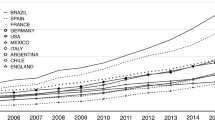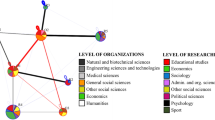Abstract
Scientific collaboration has become an important part of the people-to-people exchanges in the Belt and Road initiative, and remarkable progress has been made since 2013. Taking the 65 countries along the Belt and Road (BRI countries) as the research areas and using collaborated Web of Science (WOS) core collection papers to construct an international scientific collaboration matrix, the paper explores the spatial structure, hierarchy and formation mechanisms of scientific collaboration networks of 65 countries along the Belt and Road. The results show that: 1) Beyond the Belt and Road regions (BRI regions), Central & Eastern Europe, China and West Asia & North Africa have formed a situation in which they all have the most external links with other countries beyond BRI regions. China has the dominant role over other BRI countries in generating scientific links. The overall spatial structure has changed to a skeleton structure consisting of many dense regions, such as Europe, North America, East Asia and Oceania. 2) Within the Belt and Road regions, Central & Eastern Europe has become the largest collaboration partner with other sub-regions in BRI countries. The spatial structure of scientific collaboration networks has transformed from the ‘dual core’ composed of China and the Central & Eastern Europe region, to the ‘multi-polarization’ composed of ‘one zone and multi-points’. 3) The hierarchical structure of scientific collaboration networks presents a typical ‘core-periphery’ structure, and changes from ‘single core’ to ‘double cores’. 4) Among the formation mechanisms of scientific collaboration networks, scientific research strength and social proximity play the most important roles, while geographical distance gradually weakens the hindrance to scientific collaboration.
Similar content being viewed by others
References
Agrawal A, Kapur D, McHale J, 2008. How do spatial and social proximity influence knowledge flows? Evidence from patent data. Journal of Urban Economics, 64(2): 258–269. doi: https://doi.org/10.1016/j.jue.2008.01.003
Andersson D E, Gunessee S, Matthiessen C W et al., 2014. The geography of Chinese science. Environment and Planning A: Economy and Space, 46(12): 2950–2971. doi: https://doi.org/10.1068/a130283p
Araujo I F D, Goncalves E, Taveira J G, 2018. The role of patent co — inventorship networks in regional inventive performance. International Regional Science Review, 42(3–4): 235–280. doi: https://doi.org/10.1177/0160017618770717
Autant-Bernard C, Billand P, Frachisse D et al., 2007. Social distance versus spatial distance in R&D cooperation: empirical evidence from European collaboration choices in micro and nanotechnologies. Papers in Regional Science, 86(3): 495–519. doi: https://doi.org/10.1111/j.1435-5957.2007.00132.x
Balland P A, 2012. Proximity and the evolution of collaboration networks: evidence from research and development projects within the global navigation satellite system (GNSS) industry. Regional Studies, 46(6): 741–756. doi: https://doi.org/10.1080/00343404.2010.529121
Balland P A, Boschma R, Frenken K, 2015. Proximity and innovation: from statics to dynamics. Regional Studies, 49(6): 907–920. doi: https://doi.org/10.1080/00343404.2014.883598
Balland P A, Belso-Martinez J A, Morrison A, 2016. The dynamics of technical and business knowledge networks in industrial clusters: embeddedness, status, or proximity? Economic Geography, 92(1): 35–60. doi: https://doi.org/10.1080/00130095.2015.1094370
Bathelt H, Malmberg A, Maskell P, 2004. Clusters and knowledge: local buzz, global pipelines and the process of knowledge creation. Progress in Human Geography, 28(1): 31–56. doi: https://doi.org/10.1191/0309132504ph469oa
Bergé L R, Wanzenböck I, Scherngell T, 2017. Centrality of regions in R&D networks: a new measurement approach using the concept of bridging paths. Regional Studies, 51(8): 1165–1178. doi: https://doi.org/10.1080/00343404.2016.1269885
Boschma R, 2005. Proximity and innovation: a critical assessment. Regional Studies, 39(1): 61–74. doi: https://doi.org/10.1080/0034340052000320887
Boschma R, Martin R, 2010. The Handbook of Evolutionary Economic Geography. Cheltenham: Edward Elgar Publishing, 120–135.
Breschi S, Lissoni F, 2009. Mobility of skilled workers and co-invention networks: an anatomy of localized knowledge flows. Journal of Economic Geography, 9(4): 439–468. doi: https://doi.org/10.1093/jeg/lbp008
Breschi S, Lenzi C, 2015. The role of external linkages and gatekeepers for the renewal and expansion of US cities’ knowledge base, 1990–2004. Regional Studies, 49(5): 782–797. doi: https://doi.org/10.1080/00343404.2014.954534
Breschi S, Lenzi C, 2016. Co-invention networks and inventive productivity in US cities. Journal of Urban Economics, 92: 66–75. doi: https://doi.org/10.1016/j.jue.2015.12.003
Broekel T, 2015. The co-evolution of proximities: a network level study. Regional Studies, 49(6): 921–935. doi: https://doi.org/10.1080/00343404.2014.1001732
Broekel T, Mueller W, 2018. Critical links in knowledge networks: what about proximities and gatekeeper organisations? Industry and Innovation, 25(10): 919–939. doi: https://doi.org/10.1080/13662716.2017.1343130
Cantner U, Rake B, 2014. International research networks in pharmaceuticals: Structure and dynamics. Research Policy, 43(2): 333–348. doi: https://doi.org/10.1016/j.respol.2013.10.016
Cao Z, Derudder B, Peng Z W, 2019. Interaction between different forms of proximity in inter-organizational scientific collaboration: the case of medical sciences research network in the Yangtze River Delta region. Papers in Regional Science, 98(5): 1903–1924. doi: https://doi.org/10.1111/pirs.12438
Caragliu A, Nijkamp P, 2016. Space and knowledge spillovers in European regions: the impact of different forms of proximity on spatial knowledge diffusion. Journal of Economic Geography, 16(3): 749–774. doi: https://doi.org/10.1093/jeg/lbv042
Cassi L, Morrison A, Rabellotti R, 2015. Proximity and scientific collaboration: evidence from the global wine industry. Tijdschrift voor Economische en Sociale Geografie, 106(2): 205–219. doi: https://doi.org/10.1111/tesg.12137
Cassi L, Plunket A, 2015. Research collaboration in co-inventor networks: combining closure, bridging and proximities. Regional Studies, 49(6): 936–954. doi: https://doi.org/10.1080/00343404.2013.816412
Crescenzi R, Nathan M, Rodríguez-Pose A, 2016. Do inventors talk to strangers? On proximity and collaborative knowledge creation. Research Policy, 45(1): 177–194. doi: https://doi.org/10.1016/j.respol.2015.07.003
de Araújo I F, Gonçalves E, Taveira J G, 2019. The role of patent co-inventorship networks in regional inventive performance. International Regional Science Review, 42(3–4): 235–280. doi: https://doi.org/10.1177/0160017618770717
De Noni I, Orsi L, Belussi F, 2018. The role of collaborative networks in supporting the innovation performances of lagging-behind European regions. Research Policy, 47(1): 1–13. doi: https://doi.org/10.1016/j.respol.2017.09.006
De Prato G, Nepelski D, 2014. Global technological collaboration network: network analysis of international co-inventions. The Journal of Technology Transfer, 39(3): 358–375. doi: https://doi.org/10.1007/s10961-012-9285-4
Dong J Q, Yang C H, 2016. Being central is a double-edged sword: knowledge network centrality and new product development in U.S. pharmaceutical industry. Technological Forecasting and Social Change, 113: 379–385. doi: https://doi.org/10.1016/j.techfore.2016.07.011
Fischer M M, Griffith D A, 2008. Modeling spatial autocorrelation in spatial interaction data: an application to patent citation data in the European Union. Journal of Regional Science, 48(5): 969–989. doi: https://doi.org/10.1111/j.1467-9787.2008.00572.x
Fleming L, King C, Juda A I, 2007. Small worlds and regional innovation. Organization Science, 18(6): 938–954. doi: https://doi.org/10.1287/orsc.1070.0289
Gui Q C, Liu C L, Du D B, 2018a. Does network position foster knowledge production? Evidence from international scientific collaboration network. Growth and Change, 49(4): 594–611. doi: https://doi.org/10.1111/grow.12263
Gui Q C, Liu C L, Du D B, 2018b. International knowledge flows and the role of proximity. Growth and Change, 49(3): 532–547. doi: https://doi.org/10.1111/grow.12245
Hazir C S, Autant-Bernard C, 2014. Determinants of cross-regional R&D collaboration: some empirical evidence from European biotechnology. The Annals of Regional Science, 53(2): 369–393. doi: https://doi.org/10.1007/s00168-014-0606-4
He J, Fallah M H, 2014. Dynamics of inventor networks and the evolution of technology clusters. International Journal of Urban and Regional Research, 38(6): 2174–2200. doi: https://doi.org/10.1111/1468-2427.12007
Heimeriks G, Boschma R, 2014. The path- and place-dependent nature of scientific knowledge production in biotech 1986–2008. Journal of Economic Geography, 14(2): 339–364. doi: https://doi.org/10.1093/jeg/lbs052
Hoekman J, Frenken K, Tijssen R J W, 2010. Research collaboration at a distance: changing spatial patterns of scientific collaboration within Europe. Research Policy, 39(5): 662–673. doi: https://doi.org/10.1016/j.respol.2010.01.012
Laursen K, Reichstein T, Salter A, 2011. Exploring the effect of geographical proximity and university quality on university-industry collaboration in the United Kingdom. Regional Studies, 45(4): 507–523. doi: https://doi.org/10.1080/00343400903401618
Leszczyńska D, Khachlouf N, 2018. How proximity matters in interactive learning and innovation: a study of the Venetian glass industry. Industry and Innovation, 25(9): 874–896. doi: https://doi.org/10.1080/13662716.2018.1431524
Li Y C, Phelps N A, 2017. Knowledge polycentricity and the evolving Yangtze River Delta megalopolis. Regional Studies, 51(7): 1035–1047. doi: https://doi.org/10.1080/00343404.2016.1240868
Li Y C, Phelps N A, 2018a. Megalopolis unbound: knowledge collaboration and functional polycentricity within and beyond the Yangtze River Delta Region in China, 2014. Urban Studies, 55(2): 443–460. doi: https://doi.org/10.1177/0042098016656971
Li Yingcheng, Phelps Nicholas A, 2018b. Articulating China’s science and technology: knowledge collaboration networks within and beyond the Yangtze River Delta megalopolis in China. Chinese Geographical Science, 28(2): 247–260. doi: https://doi.org/10.1007/s11769-018-0944-8
Liu Chengliang, Gui Qinchang, Duan Dezhong et al., 2017a. Structural heterogeneity and proximity mechanism of global scientific collaboration network based on co-authored papers. Acta Geographica Sinica, 72(4): 737–752. (in Chinese)
Ma Haitao, Fang Chuanglin, Lin Sainan et al., 2018. Hierarchy, clusters, and spatial differences in Chinese inter-city networks constructed by scientific collaborators. Journal of Geographical Science, 28(12): 1793–1809. doi: https://doi.org/10.1007/s11442-018-1579-5
Matthiessen C W, Schwarz A W, Find S, 2010. World cities of scientific knowledge: systems, networks and potential dynamics. An analysis based on bibliometric indicators. Urban Studies, 47(9): 1879–1897. doi: https://doi.org/10.1177/0042098010372683
Miörner J, Zukauskaite E, Trippl M et al., 2018. Creating institutional preconditions for knowledge flows in cross-border regions. Environment and Planning C: Politics and Space, 36(2): 201–218. doi: https://doi.org/10.1177/2399654417704664
Mitze T, Strotebeck F, 2018. Centrality and get-richer mechanisms in interregional knowledge networks. Regional Studies, 52(11): 1477–1489. doi: https://doi.org/10.1080/00343404.2018.1424992
Mitze T, Strotebeck F, 2019. Determining factors of interregional research collaboration in Germany’s biotech network: capacity, proximity, policy? Technovation, 80-81: 40–53. doi: https://doi.org/10.1016/j.technovation.2018.11.001
Montobbio F, Sterzi V, 2013. The globalization of technology in emerging markets: a gravity model on the determinants of international patent collaborations. World Development, 44: 281–299. doi: https://doi.org/10.1016/j.worlddev.2012.11.017
Nepelski D, De Prato G, 2018. The structure and evolution of ICT global innovation network. Industry and Innovation, 25(10): 940–965. doi: https://doi.org/10.1080/13662716.2017.1343129
Nooteboom B, 2000. Learning by interaction: absorptive capacity, cognitive distance and governance. Journal of Management and Governance, 4(1): 69–92. doi: https://doi.org/10.1023/A:1009941416749
Pan R K, Kaski K, Fortunato S, 2012. World citation and collaboration networks: uncovering the role of geography in science. Scientific Reports, 2(1): 902. doi: https://doi.org/10.1038/srep00902
Plotnikova T, Rake B, 2014. Collaboration in pharmaceutical research: exploration of country-level determinants. Scientometrics, 98(2): 1173–1202. doi: https://doi.org/10.1007/s11192-013-1182-6
Romero C C, 2018. Personal and business networks within Chilean biotech. Industry and Innovation, 25(9): 841–873. doi: https://doi.org/10.1080/13662716.2018.1441013
Scherngell T, Barber M J, 2009. Spatial interaction modelling of cross-region R&D collaborations: empirical evidence from the 5th EU Framework Programme. Papers in Regional Science, 88(3): 531–546. doi: https://doi.org/10.1111/j.1435-5957.2008.00215.x
Scherngell T, Barber M J, 2011. Distinct spatial characteristics of industrial and public research collaborations: evidence from the fifth EU Framework Programme. The Annals of Regional Science, 46(2): 247–266. doi: https://doi.org/10.1007/s00168-009-0334-3
Scherngell T, Hu Y J, 2011. Collaborative knowledge production in China: regional evidence from a gravity model approach. Regional Studies, 45(6): 755–772. doi: https://doi.org/10.1080/00343401003713373
Ter Wal A L J, 2014. The dynamics of the inventor network in German biotechnology: Geographic proximity versus triadic closure. Journal of Economic Geography, 14(3), 589–620. doi: https://doi.org/10.2307/26158732
Ter Wal A L J, Boschma R, 2011. Co-evolution of firms, industries and networks in space. Regional Studies, 45(7): 919–933. doi: https://doi.org/10.1080/00343400802662658
Yoon J, Blumer A, Lee K, 2006. An algorithm for modularity analysis of directed and weighted biological networks based on edge-betweenness centrality. Bioinformatics, 22(24): 3106–3108. doi: https://doi.org/10.1093/bioinformatics/btl533
Author information
Authors and Affiliations
Corresponding author
Additional information
Foundation item
Under the auspices of Strategic Priority Research Program of the Chinese Academy of Sciences (No. XDA20010103)
Rights and permissions
About this article
Cite this article
Gu, W., Liu, H. Spatial Structure, Hierarchy and Formation Mechanisms of Scientific Collaboration Networks: Evidence of the Belt and Road Regions. Chin. Geogr. Sci. 30, 959–975 (2020). https://doi.org/10.1007/s11769-020-1161-9
Received:
Accepted:
Published:
Issue Date:
DOI: https://doi.org/10.1007/s11769-020-1161-9




